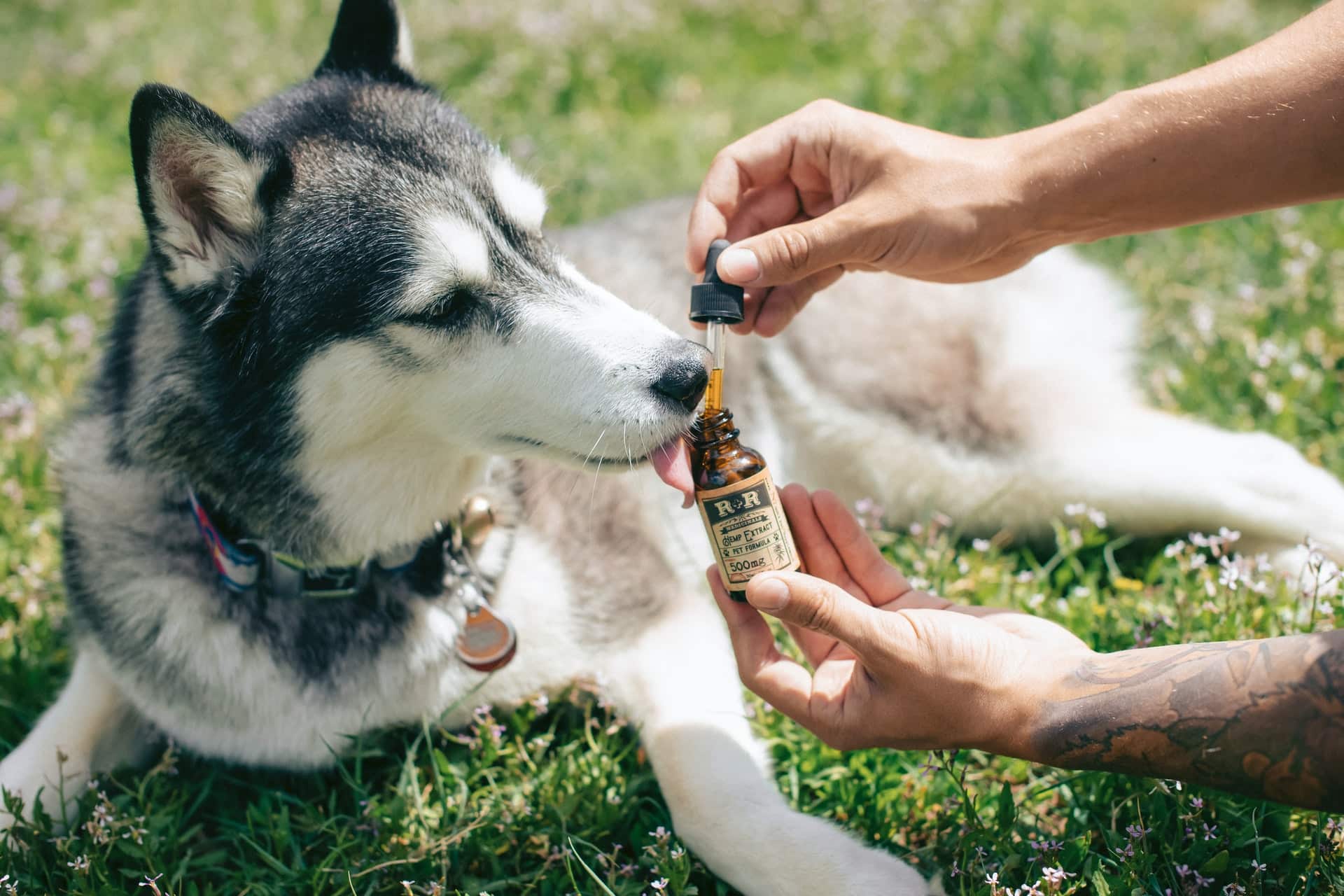So, today you decided to take your furry friend out for a walk and a playdate in a new gorgeous dog park right around the corner. However, after a while, you’ve noticed your puppy has started to chew on its feet and excessively scratch around its ears.
Now, you’re not a veterinarian – but this definitely isn’t your dog’s normal behavior. Could it be your dog has an allergic reaction? And most importantly – what could’ve caused it?
At this point, you’re not so sure since you’ve changed their diet recently and the park environment is new to your pup.
Unfortunately, we rarely know what triggers an acute allergic reaction in dogs; various factors could cause it. But in this in-depth guide, you’ll learn exactly what causes allergies in dogs, which types of allergies are there, and what are the treatment methods.
Let’s get going!
Allergic Reactions in Dogs 101

Allergic reactions are defined as a condition in which the immune system overreacts and becomes hypersensitive to a substance known as an allergen. The majority of allergens are proteins derived from plants, insects, animals, or foods.
Repeated exposure to the allergens – over a period of months to years – sensitizes the immune system, and further exposure to the same or similar allergen induces an over-reaction we recognize as clinical signs of an allergic reaction.
Normally, the immune system defends the dog against infection and disease. However, in the case of allergic reactions, the immunological reaction can be damaging to the body.
Allergies might be viewed as an unneeded natural immunological reaction to a harmless foreign chemical.
Allergy-related immunological responses are highly complicated. The majority of allergic responses are caused by allergen protein molecules interacting with antibodies in the blood and then adhering to a kind of cell known as a mast cell.
Mast cells can be found in a variety of tissues throughout the body. They release strong compounds – such as histamines – when antigen and antibody react with them, causing a localized reaction such as redness, swelling, and itching.
The varied signs and symptoms of your dog’s allergies are caused by this inflammation.
What Are The Most Frequent Allergens?

A wide range of chemicals can act as allergies. The majority are proteins derived from insects, plants, or animals – although tiny chemical compounds can also cause allergies.
Pollens, mold spores, dust mites, shed skin cells – similar to pet allergies in humans – insect proteins, such as flea saliva, and various drugs are examples of frequent allergens.
Acute Allergic Reactions In Dogs

An acute allergic response in dogs is a life-threatening condition that is perhaps the most frightening of all forms of allergies in dogs. If they have a severe allergic response, dogs can go into anaphylactic shock – much like humans.
And if not addressed, this can be lethal.
Anaphylactic responses in dogs could be caused by a variety of things, including insect bites (such as bee stings) and vaccination reactions, which is why it’s always a good idea to keep a watch on your dog after receiving a new vaccine, medication, or food item.
Fortunately, anaphylactic reactions in dogs are uncommon.
Common clinical signs that your dog may develop include hives or face puffiness. A swollen face, neck, lips, eyelids, or earflaps might appear alarming – but it is seldom deadly, and it may be treated with an antihistamine by your veterinarian.
What Is An Anaphylactic Reaction?

An anaphylactic reaction, also known as anaphylaxis, is a serious – and sometimes life-threatening – hypersensitivity (allergic) reaction to a foreign substance, particularly a foreign protein known as an allergen or antigen.
And yes, it requires an emergency vet visit.
What Can Cause An Anaphylactic Reaction In Dogs?

An anaphylactic response can develop only if your pooch has already been exposed to the offending material.
A frequent example is a dog bitten by a bee who develops an allergy to bee sting later in life:
When the dog gets stung for the first time, a short-term localized response ensues. This reaction will induce the immune system to create Immunoglobulin E (IgE), which attaches to the surface of mast cells.
The redness and swelling (hives) at the location of the insect bite are caused by mast cells. And at this moment, the dog is considered to be sensitized to the bee’s venom.
When the dog’s stung again, the sensitized mast cells detect the foreign protein (bee toxin) and release their contents – a process known as degranulation and activation. A localized allergic reaction, such as severe swelling at the location of the bee-sting, will occur in milder cases of anaphylaxis.
In severe responses, the localized reaction causes the contents of mast cells to be released throughout the body, resulting in systemic anaphylaxis.
However, local allergic responses are common, while systemic anaphylaxis is uncommon.
In theory, any foreign material can cause an anaphylactic response – but these are the most common:
- Food proteins
- Insect stings
- Drugs
- Antigens in vaccinations
- Environmental contaminants
- Chemicals
It’s critical to understand that anaphylaxis is an atypical reaction. The immune system of the organism overreacts to the foreign protein or chemical, resulting in an exaggerated response.
The majority of instances of anaphylaxis are assumed to be inherited or familial.
Clinical Signs: What Are The Symptoms Of An Anaphylactic Reaction in Dogs?

The amount of antigen, the mode of exposure – mouth, skin, inhalation, injection – and the intensity of the pet’s IgE reaction all have a role in the severity of clinical signs.
A dog experiencing an anaphylactic shock will have difficulty breathing and might be cyanotic if it has systemic anaphylaxis, characterized by a bluish color to the tongue and gums.
The other most common signs of an anaphylactic shock are:
- Itching
- Localized allergic reactions in dogs (red skin swellings called wheals or hives)
- Swollen face or snout
- Difficulty breathing (respiratory distress)
- Increased salivation and runny nose
- Abnormal heartbeat
- Drooling
- Vomiting
- Diarrhea
- Reduction in clotting factors
How Is An Anaphylactic Reaction Diagnosed?

History of recent exposure to an offending chemical and the presence of distinctive clinical signs are used to diagnose anaphylaxis.
Blood tests could indicate elevated liver enzymes and dehydration in extreme instances – such as hemoconcentration. An enlarged liver, edema in the gallbladder wall, and fluid around the abdominal organs can all be seen on an abdominal ultrasound.
To detect particular allergies, later on, intradermal skin testing and IgE blood tests may be undertaken.
Treating Anaphylaxis: How Is An Anaphylactic Reaction Treated?

Anaphylactic shock is a medical emergency; it requires immediate medical attention and prompt treatment.
When feasible, the initial action is to remove the triggering material – such as a bee’s stinger.
Following that, the pet is stabilized to prevent or reduce systemic shock by keeping their airway open – especially in case of severe respiratory signs – and maintaining stable blood pressure and circulation.
Furthermore, intravenous fluids, a breathing tube, and the injection of emergency medication, such as epinephrine, corticosteroids, atropine, and/or aminophylline, are frequently required.
In moderate cases, antihistamines and maybe corticosteroids may suffice, and your dog might need to be monitored closely for the next 24-48 hours until full recovery.
Is An Anaphylactic Reaction Serious?

A cautious prognosis is always given at the outset. It’s often hard to predict whether a small or modest reaction will escalate into a large catastrophe.
Because anaphylactic responses frequently worsen with each episode, the primary objective is to avoid further exposure to the offending foreign substance.
If your pet suffers from anaphylaxis, you may be given emergency drugs to store at home – and advice on what to do if your pet exhibits any indications of a response.
Other Types Of Dog Allergies

Signs of an acute allergic reaction on a dog are the easiest to spot and are the most serious ones. But there are other types of allergies that may affect your four-legged friend.
Skin Allergies
The most prevalent form of allergic response in dogs is skin allergies, often known as allergic dermatitis. Skin allergies in dogs are generally caused by three factors:
Environmental allergies
Atopic allergic responses or atopic dermatitis can be caused by environmental allergens such as dust, pollen, and mold.
These are often seasonal allergies, so you might notice your dog scratching only during particular seasons of the year.
The most typically afflicted regions are the ears or paws, but also include the muzzle, wrists, ankles, underarms, around the eyes, groin, and in between the toes.
Food allergies
Itchy skin might also be caused by food allergies and sensitivities. Dogs with this type of allergy frequently scratch their ears and paws – which could be accompanied by gastrointestinal signs.
Flea allergy (dermatitis)
An allergic response to fleabites or insect bites causes flea allergy dermatitis. Flea saliva can lead to allergies in certain dogs.
The affected dog’s skin becomes red, inflamed, and scabbed, and it becomes highly itchy, especially at the base of the tail. You’ll also observe flea indications, such as flea filth, or even the fleas themselves.
Note: Secondary infection is a danger with all skin allergies. When your dog scratches, chews, or licks his skin, he exposes himself to yeast and bacterial infections, which may demand treatment.
Food Allergies In Dogs
True food allergies cause an immunological reaction, which can manifest as skin disorders (hives, face puffiness, irritation), gastrointestinal symptoms (vomiting and diarrhea), or a mix of the two.
Severe reactions culminating in anaphylaxis can develop in severe cases – analogous to severe peanut allergies in people.
But true food allergies might be less frequent than people believe.
Food Intolerance Vs. Food Allergy

When they indicate that their dog has a food allergy, most people mean that their dog has a food sensitivity – also known as food intolerance.
Food sensitivities, unlike real allergies, are a progressive reaction to an irritating item in your dog’s food, such as beef, poultry, eggs, corn, wheat, soy, or milk.
Food sensitivities in dogs can cause a variety of symptoms, including gastrointestinal symptoms such as vomiting and diarrhea, as well as dermatologic symptoms such as itching, poor skin and coat, and persistent ear or foot infections.
Working with your veterinarian to manage your dog’s symptoms and identify the component causing the response is the best method to diagnose and treat a food allergy.
Inhalant Allergy (Atopy) In Dogs
Inhalant allergy in dogs is frequently used as a synonym for atopy.
Tree pollens (cedar, ash, oak, and so on), grass pollens, plant pollens (ragweed), molds, mildew, and home dust mites are the most common inhalant allergens.
Ragweed, cedar, and grass pollens, for example, are seasonal allergies. Others, such as molds, mildew, and home dust mites, are present all year, though.
When humans inhale these allergens, the allergy typically appears as upper respiratory symptoms such as runny eyes, runny nose, and sneezing (hay fever).
Although allergic rhinitis or bronchitis are sometimes signs of allergies, unlike humans, most dogs experience itchy skin (pruritus) due to these inhalant allergies.
Because of these clinical signs, the disorder is also known as inhalant allergic dermatitis. The dog may lick its feet and face, or scratch its axillae (underarms).
Most dogs with inhalant allergies begin to exhibit symptoms between the ages of one and three years. Affected dogs frequently respond to many allergens and frequently have flea or other types of allergies at the same time.
If the allergens can be discovered via intradermal skin tests (skin testing) or blood tests, your pooch should be kept as far away from them as possible. That’s problematic because the majority of these allergens are environmental, and recurring attacks are expected.
On that note, atopy symptoms can be managed – but a permanent cure is typically not attainable.
The Telltale Signs Of Allergies In Dogs

Allergy symptoms in dogs might vary depending on the reason.
A dog in anaphylactic shock, for example, will have a drop in blood pressure followed by shock, which, as we can all agree, is not the same as a skin disease.
However, in general, the following signs may indicate an allergic response:
- Hives and hot spots
- Vomiting
- Facial swelling, lips, eyelids, ears, or earflaps
- Red, inflamed skin
- Diarrhea
- Itchiness
- Sneezing
- Itchy ears
- Constant licking
- Chronic ear infections
- Itchy, runny eyes
- Loss of fur
- Hyperpigmentation (black spots)
Note: Some of these signs and symptoms might indicate the presence of another illness. Make an appointment with your veterinarian to receive an accurate diagnosis and assistance in helping your dog feel better.
How Are Allergies In Dogs Diagnosed?
If you’ve ever had allergy testing, you know that determining allergies may be difficult.
The first step that your veterinarian may take is to rule out any other conditions that might be causing your dog’s symptoms. The vet usually first performs a thorough physical examination to determine which areas are affected.
If your veterinarian believes that an allergy is a possible cause, they may recommend allergy testing to try to identify the allergen causing the response. If you want to skip a trip to the vet, you can do allergy testing at home:
5Strands Pet 335 Test for Dogs is perfect for the job!
However, bear in mind that testing may not always be able to pinpoint the reason for an allergy.
An elimination diet is frequently used to identify food sensitivities. A food trial involves giving a dog a new (i.e., novel) protein and carbohydrate source for 12 weeks.
Flea allergy dermatitis is the most common kind of allergy. Typically, it is diagnosed by finding fleas on your dog’s body and using a solution that kills fleas before they can bite to determine whether it resolves the problem.
How Are Allergies In Dogs Treated?

Avoiding the source – the allergen – is the most effective method to treat an allergy. That may or may not be possible at all times.
However, therapy is generally dependent on the type of allergy in your dog.
For example, killing fleas is the best approach to treat flea allergy dermatitis, but changing one’s diet is the best way to treat a food allergy or intolerance.
In addition to any necessary lifestyle modifications, your veterinarian may prescribe an allergy relief medicine (corticosteroids) for your dog to help reduce the symptoms of the allergic reaction on a dog, including itching and secondary skin infections that may arise as a result of the irritant.
In most situations, anti-inflammatory medicines such as corticosteroids or antihistamines will swiftly stop the allergic reaction. In rare cases, dietary fatty acid supplementation could increase sensitivity to steroids and antihistamines.
Also, bathing with a hypoallergenic shampoo regularly can be soothing to itchy, sensitive skin. Bathing also removes allergens that might be absorbed via the skin from the coat. Some therapeutic shampoos also contain anti-inflammatory chemicals, which might be beneficial to your pet.
That said, if the precise problematic antigens are discovered through allergy testing, your dog might be given an allergy injection serum or allergy injections. Weekly injections of extremely modest doses of the antigen are used in this therapy.
The goal of this recurrent dose is to reprogram or desensitize the immune system.
The success rate of this therapy varies, though. Approximately 50% of treated dogs will likely exhibit considerable improvement in their clinical symptoms, while another 25% would see a reduction in the quantity or frequency of corticosteroid use.
Lastly, if your dog is having a serious allergic reaction, the best thing you can do is bring him to an emergency veterinary facility as soon as possible.
Are Allergies In Dogs Common?
Allergies are unfortunately fairly frequent in dogs of all breeds and origins. The majority of allergies emerge once the pet is six months old, with the majority of afflicted canines being over the age of one or two.
While we’re at it, are allergies hereditary?
Some allergies are considered to be passed down via families. Atopy, or allergies to pollens and plants, is an example of a hereditary allergy.



